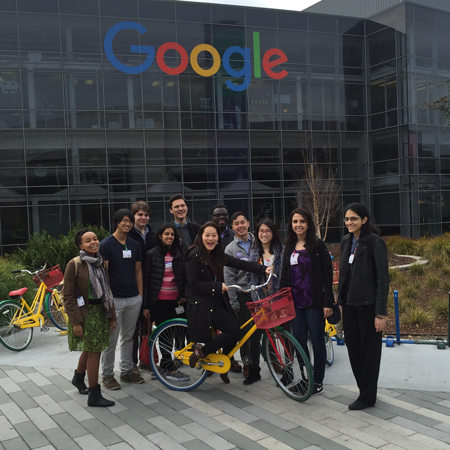February 3, 2016
Emmanuel Osunlana '18

When struggling with motion sickness, the best strategy is to sit completely still and look straight ahead. It has a grounding effect. I had to employ this tactic after my first experience driving through the snaking streets of San Francisco. My inaugural foray into the city marked the beginning of the Amherst Career Center’s Innovation Trek, and our first stop was the home of Kelly Close '90, founder of Close Concerns.
As I sat unmoving in Ms. Close’s beautiful home, I ruminated on the uncertainty of the future—I do this often. My thoughts led me to the question of what I want to do with my future. Although the trek did not lead to any concrete answers, it helped me ask more nuanced questions about the future.
The Innovation Trek is an opportunity for 12 Amherst College students to meet alumni working in various sectors of Silicon Valley (e.g. tech, venture capital, startup, and private equity). The program is in its second year and is open to students from all class years and majors. Students apply for one of 12 spots and the trip was financed through the Christine Noyer Seaver and Alexander Seaver President's Discretionary Fund, a permanently endowed fund established in 2013 that supports a variety of student and faculty projects each year.
Over the course of a week, we met alumni during networking events, site visits, receptions and roundtable discussions. Alumni shared how their career paths led them from the East to the West Coast, and we heard firsthand accounts of how they leveraged a liberal arts background to succeed in tech fields. Despite divergent career paths, alumni echoed the same message: know yourself in the context of your career goals.
On the third day of the Trek, Gib Biddle ’84, a product advisor to start-ups, provided a framework to help us analyze our strengths. He asked us if we were starters, builders or maintainers. Starters challenge the status quo with new ideas, builders scale a small idea into a big proven concept, and maintainers keeps the company running smoothly. The most successful ‘unicorns,’ startup companies with a market cap above $1 billion, have teams composed of starters, builders and maintainers. No specific skill class is better.
While I listened to Mr. Biddle speak, I thought back to the question of my future and what I hoped it would look like. Naturally, I jumped to the idea of being a starter—who doesn’t want to be the next Zuckerberg? But I quickly realized there is no specific idea that I am willing to make my life’s mission, and that my current skill class is more of a builder. Through guided self-analysis I was better able to think about my current skills.
The following day, Mark Perry '65, former general partner at the venture capital firm NEA, added another layer to help us think about our skill profiles. He encouraged us to ask: does this job uniquely play to my strengths? Suppose an individual has two skills, one with excellent competency and the other with average. If this individual takes a job that caters to that greatest strength, he or she will flourish. However, if the job requires the lesser skill, this individual will likely stagnate. The key is making sure that the job not only fits one’s strengths, but that it uniquely does so. By being able to evaluate how my strengths coincide with potential work opportunities, I felt better prepared in next deciding where to start my career.
Jason Spero ’94, vice president of performance media at Google, framed the question of where to begin most clearly. He asked us to weigh the benefits and drawbacks of joining a young, small company or an established, big company. Young companies are fighting to succeed so there is an expectation of immense responsibility and autonomy from the get-go. The stakes are higher; failure could swallow one whole at any moment. However, high risk may result in high reward. On the other hand, established companies provide valuable training programs and resources to facilitate learning and growth, albeit at a slower pace. Also, big companies have superb training programs that provide an excellent platform to dive into more uncertain waters later. Whether joining a big or small company, the decision must balance skill with job responsibilities and future growth.
Throughout the trek we met with nearly a dozen alumni. Self-evaluation was a constant theme. Alumni challenged us with new perspectives and questions. Each time I tried to honestly assess of my skills, experience and goals. It strikes me that the strategy for struggling with motion sickness also works for the equally nausea-inducing transition from college student to independent adult. By sitting still and looking straight ahead, I am not only thinking about the future; I am also thinking about the future in relation to where I currently am.
On that first evening of the Innovation Trek, Ms. Close gave me a glass of sparkling water and checked on me until my motion sickness had passed. At the risk of abusing my metaphor, I will add that her compassion for an individual she had just met is similar to the support that alumni can provide to a student who is sitting still and staring straight ahead (i.e. thoughtfully analyzing the future). Introspection need not be done alone when we have amazing alumni who are willing and qualified to offer advice and help us navigate the path ahead.
Students: Visit the Career Center in College Hall to learn more about how to participate in a career trek.
Alumni: The Career Center organizes 3-4 treks each year. Interested in meeting students at a trek in your city? Please contact Emily Griffen, at egriffen@amherst.edu or (413) 542-2265. For information on how to support future treks, please contact the Advancement Office at (413) 542-5900.